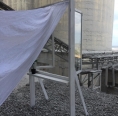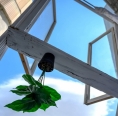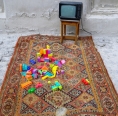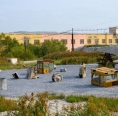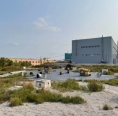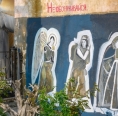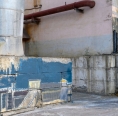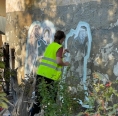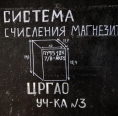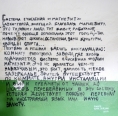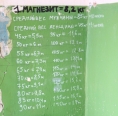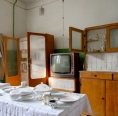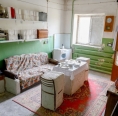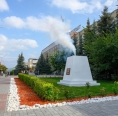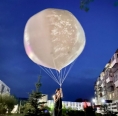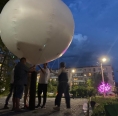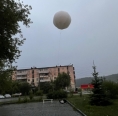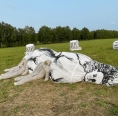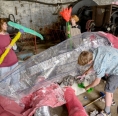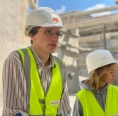-
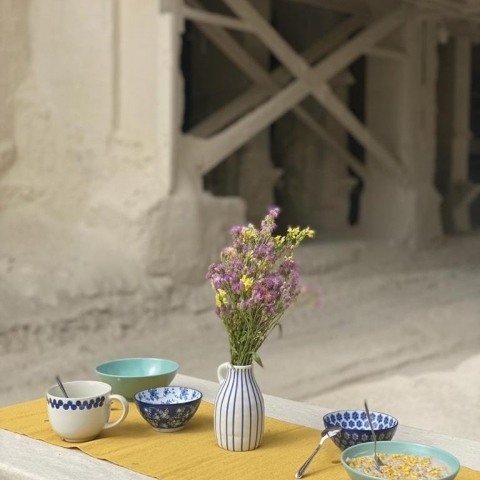
FROM MILE BALLOONS TO MURAL
Students of experimental workshop of Kamenkovich-Krymov of the Director’s School in the Russian University of Theatre Arts presented objects of art created in the Satka region as part of the joint artistic laboratory of the Sobranie Fund and Russian University of Theatre Arts (GITIS) to the Satka residents. The presentation was held in the Magnezit Museum on August 10.
The projects for artistic improvement of Satka were created by the stage designers and painters under supervision of their teachers: painter Irina Korina and art critic Dmitry Butkevich. The students got their inspiration during the first visit to the town in February of this year. During their next visit the students realized their ideas. As a result the district gained 8 new objects of art which will become a part of the route planned for Ural Industrial Biennale of Modern Art (the route to Satka is considered to be one of the most popular ones, the free tickets for August have long run out, and the closest one can get are only for September).
One of the first to finish their project is Marusia Pavlola, who presented Mile Balloons. Three white balloons filled with helium were placed in several places around the town symbolically connected with ending of life or endings of other processes. The fists one is at the start of Solnechnaya Street, at the place where the old cemetery was located prior to construction. The second one is near the monument of the Sickle and the Hammer, which symbolizes the passing era of 90s privatization. The third one is in the area of the Karaguy Pit, which means the running out of resources.
“The project turned out to be beautiful but intangible. The evening we finished setting up the balloons they were blown away by a hurricane”, noted Dmitry Butkevich.
At the same time as the Mile Balloons an Explosion Monument was installed near the Magnezit Group office building. It is a plywood structure shaped as a pyramid, every day at 16.00 it produces a plume of smoke (at this time the rocks are blown up in the Karaguy Pit).
“The geography of Satka constantly changes. New pits appear and the old ones close. After some time surface production of magnesium carbonate will be given up as well. But we must remember it, remember the pit explosions and the generations who bore witness to all of that”, believes the project’s author, Martyn Stepanov.
Two projects introduce mythology to the spaces: The turbine building of the Porozhskaya HPP, and a place near the turn to Magnitka village from M-5 highway. Their authors, Peter Voznesensky, Arina Kleparskaya and Varvara Baboshina, tried to imagine what once have been and what will happen in the future.
“After our first visit to Satka we understood that the topics most exciting for us are connected to the history of the town. The duration, unpredictable future and mysterious flow of this history. We were worried about condition of the monuments and their safety. How is Satka’s history recorded? Which facts are true, and which are false? What can be done about the missing information? Who knows, there just might have been some ancient Greek explorers visiting Satka”, said Varvara Baboshina. “This was the birth of our project “Ruins” – a gigantic structure of hay and cloth, a statue of Venus and shapes of columns. A myth about how they were found here. As the time goes by the installation will naturally decompose and get covered with grass, turning into more of a ruin than it is now.
The HPP impressed the painters with its unimaginable beauty. Today its building is cold with the windows shattered. But it still has German tools and machines, which no longer exist in Germany itself. The authors tried to imagine who worked at the HPP and what they were doing. What happened at the HPP at night? Whether there were multicolored rats running there, or if the workers planted some unimaginable flowers.
The remaining objects of art were installed at the Satka production site of the Magnezit Group. Anna Gorina created a Stone Garden. However, instead of stones the painter used waste parts which were usually submitted as scrap metal.
“The most common objects which were once only valuable for production will get a new job – to be looked at and appreciated. I think that this work, similar to the true Japanese stone garden, will make the viewers think about their place in the world, about ending of service life for all these mechanisms which can now only take the place of stones”, explained the author. Her project is located near a poplar alley leading to the multiple-hearth furnace building No. 3.
Lialia Golysheva and Peter Voznesensky designed a worker’s room which space had slowly integrated with the plant and became one monolith object as the time went by on the territory of multiple-hearth furnace building No. 1. Ekaterina Erdeni created a plant worker’s room where life is governed by measurement unit of one magnesium carbonate (conventionally 1 piece of magnesium carbonate weighing approx. 8 kg) in the Hangar. Magnesium carbonate is the system-forming term for the entire Satka. The viewer can see the objects from forks to cabinets converted into this measurement system which works similar to translation into a different language or conversion to other currencies. For example, a TV can hold 4.5 pieces of magnesium carbonate, average weight of an adult man is approximately 10 pieces of magnesium carbonate, etc.
Project of a Mural by Valya Nikolaichuk dedicated to reinterpreting of one’s actions was left incomplete. Works of the painter can be seen on the territory of the grinding and separating plant.
“Initially I had a completely different project, unfortunately, it was impossible to bring to life. I had to start the work from zero. That’s why time was insufficient, but I will surely return to complete my work”, said Valentina.
“Out objects of art are mostly intended for guests of Satka. We wish that looking on them allows the visitors to recognize Satka’s reality: cultural, psychological and life aspects. To better understand the ideas which were expressed by the authors in their project we will issue a guidebook with the results of our work”, added Dmitry Butkevich.
Source: Magnezitovets. Photo by Vasily Maksimov, Denis Shakirov, Anna Filipova, Irina Korina, Anna Dubrovskaia.
-
26.08 - 26.08
DIARY OF THE THIRD INDUSTRIAL BIENNALE
-
28.11 - 28.11
MY SATKA FESTIVAL WINS THE CONTEST OF CORPORATE VOLUNTEER PROJECTS
-
13.10 - 15.10
COOPERATION WITH VGIBL NAMED AFTER M.I. RUDOMINO

